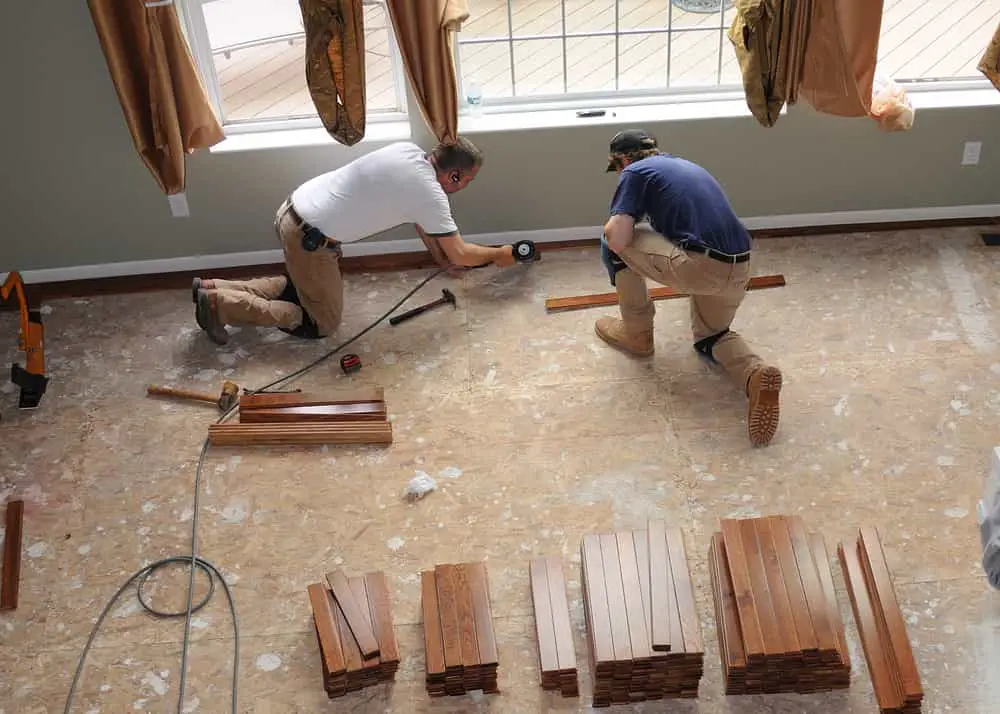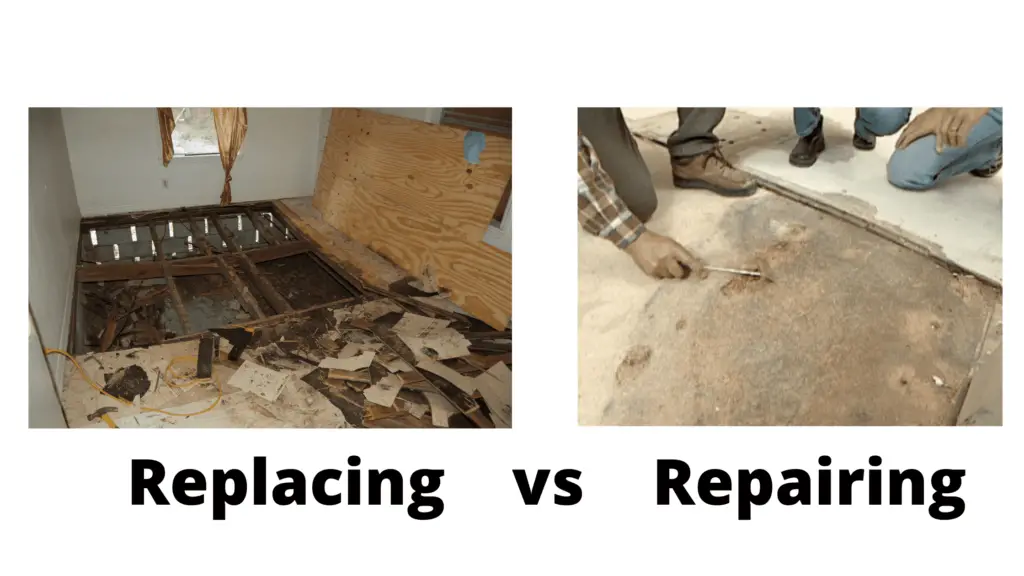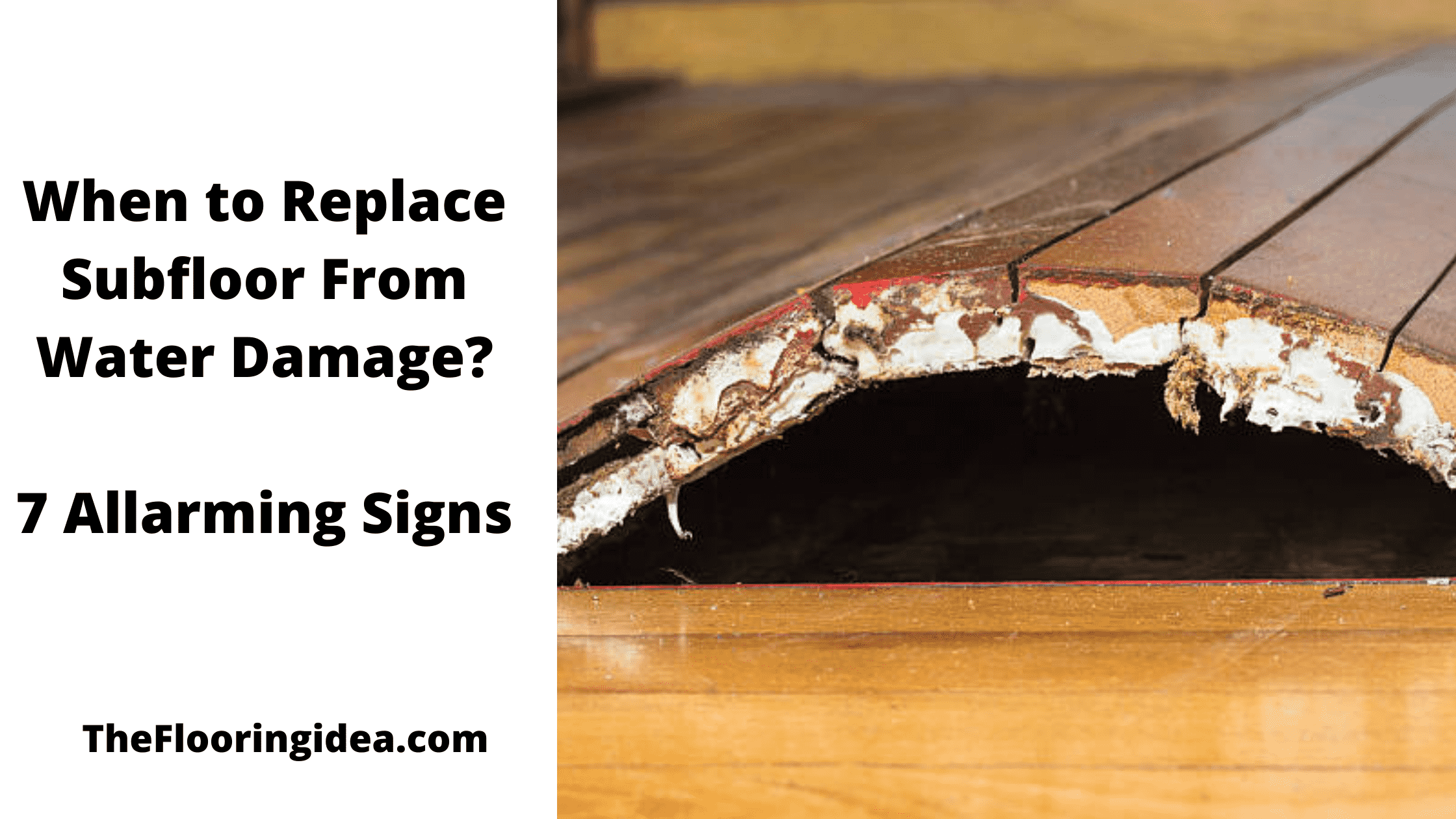You probably don’t know when to replace the subfloor from water damage because you don’t know what goes on under the flooring like hardwood, laminate, tile, or carpet.
Usually, the subfloor damage gets attention during full-scale renovation or at the last stage when it is too late for your subfloor surface.
This would be costly for you because when it is too late, you may need to remove both surface flooring and subflooring.
But not now because in this guide I am going to tell you when to replace a subfloor from water damage and a complete process to replace a subfloor.
Before we start, first you should know the purpose of a subfloor.
What is Subflooring?

The flooring under the mail-walking floor is called a subfloor. The main purpose of a subfloor is to protect the surface flooring from water and moisture damage.
Also, a subfloor provides support to surface flooring and is attached to its joists. In some houses, the plumbing pipes and electric wiring run through the subflooring.
Almost every surface floor needs a subfloor because the surface flooring is not attached to joists and won’t be able to hold high foot traffic by itself.
What difference between Subfloor and underlayments?
Technically, the subfloor is a structural part of a home that provides support and strength to a home’s surface flooring. While underlayments are used to provide comfort underfoot, soundproof a floor, and protect a surface floor from moisture damage as well.
9 Signs Of Water Damage Under The Floor
1. Loud Floor Squeak
It is not even noticeable for a flooring surface to have a little squeaking, especially for hardwood plank surface flooring. But this can create a big issue because this could be a sign of water or moisture damage under the floor.
Often the floor squeak occurs when the subflooring gets loosened from the joists. And in a result, the surface floor will be able to move a little bit up and down while walking on it.
So the water or moisture damage can be a reason.
2. Floor Cracking
There are high chances of surface floor cracking due to the high moisture level under it. Once water or moisture starts damaging then they both know how to get into places where they don’t even belong.
In the end, the surface flooring starts seeping water and moisture quickly leads to floor cracking.
So, the cracking of surface flooring is a clear sign there is something wrong under it.
3. Floor Cupping- Hardwood
Whenever the water seeps into the surface flooring like a hardwood floor, it leads to cupping. Because the side of the board gets damaged by water or moisture will expand.
And when the board edges expand than the center of the board the floor surface looks incurved.
So, this is a sure sign of water damage that will lead to serious structural problems.
4. Unstable Surface Floor
Whenever a surface floor provides an uncomfortable and unstable feel while walking on it. That means the floor begins to sink between the joists.
And this is just because of the high moisture level under the surface flooring. And you need to replace the subflooring immediately if you want to save the surface flooring.
5. Bad Room Smell
Have you ever felt a musty smell in your room, especially from the surface flooring?
If, so you are dealing with damaged subflooring. So if you feel this bad and musty smell regularly this is a clear sign of water damage under the surface flooring.
6. Painted Walls Get Damaged
Surely, the damaged painted walls do not look like a subfloor fault but this may be a sign that your home/room dealing with a high moisture level or water leakage somewhere.
Often the hardwood floors are good absorbers of moisture. So, there are chances, that the surface flooring brings this moisture from the subfloor surface and walls are getting damaged because of this moisture.
7. Moisture/Water Leaking
In the last direct water leakage from the surface flooring is an obvious sign of subfloor damage. This stage is most critical because after this your surface flooring will remain a piece of waste within a few days.
So, if you are dealing with this stage you have to take the right step immediately.
8. Peeling Paint
Peeling paint is another indication that water has been absorbed into the subfloor. If you have recently painted your walls and find that they are peeling in certain areas, it’s likely that the subfloor has taken on water and needs to be addressed.
Moreover, paint that flakes off from the wall can also accumulate on the surface of the subfloor, making it difficult for any new materials to stick properly.
9. Visible Mold
Mold is one of the most common indications that you have a water problem in your home, and it’s important to address it right away. Visible mold on walls or floors could indicate that there are hidden issues with your subfloor, as well as other areas in your home.
If you notice visible signs of mold growth, it’s important to consult with a professional to ensure all moisture-related issues are addressed properly before replacement begins.
Reasons Why a Subfloor Gets Damaged by Water:
Water Pipes Bursting
Poor plumbing material leads to bursting the water supply lines under the surface flooring. That can badly damage the subfloor because of excess water leakage.
So, this is one of the most common reasons why a subfloor gets damaged by water.
You can save your floor from this hassle when you are installing and fixing the pipelines under it. You need to buy high-quality materials and also fix them well.
Wrong Material
The selection of the wrong material for your subfloor is also leading to a reason. Hidden water leakage at a low level is a common thing under the surface flooring.
But if your subfloor material is not able to resist the low amount of water or moisture that means you have chosen the wrong material for your subflooring.
Plywood is one of the most common and popular subflooring materials. So, the standard and recommended thickness for plywood subflooring should be 15/32 inches if the underlying floor joists have 16 inches or less space.
Plywood material is more water and moisture-resistant. Also, it screws better than OSB but OSB is less expensive than plywood.
So, the point is you have to choose a material that should be water and moisture-resistant.
Natural Disasters
Storm flooding is an unstoppable disaster that can badly damage both subfloor and surface floors. You can’t stop it when floodwater goes into your home’s crawl space.
After a natural disaster, the only option that remains is you have to replace both floorings.
Exterior Home Cracking
Exterior cracks would be a reason for subfloor damage. When it’s raining, there are high chances of water or moisture leaking into the subfloor surface through these cracks.
And this moisture will slowly or fast damage the surface and spread all over the surface. As a result, the surface flooring will show signs of water damage.
How to Keep Safe a Subfloor From Water Damage
Water-resistant flooring material
No matter what type of surface flooring you have you need to choose water-resistant flooring material for subflooring.
This will eliminate the water damage that is coming from under the surface floor.
Plywood material flooring is one of the most popular subflooring because it is more water-resistant than any other. Most importantly it is highly recommended as a subflooring material.
No doubt there are many flooring materials that are water-resistant but most of them are more suitable as surface flooring.
So, you have to go with an option that is not only water-proofing but also provides better results overall as a subflooring material.
High-Quality Plumbing pipes
As I told you above the water pipes bursting or leakage could be a reason for surface floor damage. So you have to choose high-quality and more durable water pipes that can bear high water pressure. And won’t get damaged soon.
PVC rigid pipes are most used for highly pressurized water. These pipes can be used for both transporting potable water and also for draining.
Related Topic: Best Waterproof Subfloor Material: 6 Options
Should you repair or replace a Water Damaged Subfloor?

Replacing and preparing a damaged subfloor depends on its current state. If you understand the water damage signs immediately and begin the drying process.
There are high chances, you don’t need to replace it.
But you have to spot it within 48 to 72 hours then you would be able to repair it.
For you, this would be best to contact a flooring restoration expert. You will find an accurate solution and direction after his assessments.
while if the floor already has extensive water damage, it would be difficult to repair it. So, in a situation like this replacing a floor will be a better option.
Because if you don’t do this immediately, it will be more costly for you.
How to Replace a Water-Damaged Subfloor
Removing the Old One
To replace a subflooring first you need to remove the existing one. Remember when you are going to replace a subfloor you need to remove it completely. When you go with repairing you have to remove just the damaged parts or areas.
As I mentioned above, replacing a subfloor is only an option when extensive water damage happens to all the subfloor areas. Not only a few parts.
So, don’t confuse between replacing and repairing a subfloor.
To cut the subflooring you need a cutting saw. Cut the flooring until you reach the solid structural framing. After removing it completely let the surface dry.
To remove the spreading debris during the whole process you can use a vacuum cleaner.
Measure, Cut, and Install
Measure the complete area where you want to install the new one. And cut the material as needed. After this, Install the new one!
How to repair a Water damaged Subfloor
Damage Assessment
To repair a subflooring the very first step is to determine the cause of damage. You have to find out where the water or moisture is coming from.
As mentioned above, the water leakage could be due to plumbing pipes bursting or exterior cracking or it could be from anywhere else.
It is important because when you find the cause it will be easy for you to stop it from doing more damage.
Fix the Water Leakage
Fixing a damaged subfloor from water leakage without fixing the leakage first is like you are just wasting your time. And it will not make even sense.
So, before you get started you need to stop the water leakage.
Determine the Damaged Area
After fixing the water leakage now you have to determine the damaged area you are going to repair. Finding the damaged areas is easy because the areas that are showing more bad water-damaged signs are highly needed to repair.
Mark these areas and let’s repair them!
Start Repairing the Subfloor
There are two types of repair one is the drying process and the other is removing the damaged parts.
If you spot at the right time or soon that floor is getting damaged by moisture or water. Then you can use the drying process method.
Because in that case subfloor is still alive and could be repaired in its previous condition by drying the surface.
But if you are late to spot that subfloor is getting damaged by water then you have to replace the damaged areas. Because water can badly damage a subfloor surface when it continues doing it for a long time.
Drying process: First examine the area from where the water or moisture is coming. Dry the standing water with a dry or wet mop.
By running a ceiling fan or opening the room’s windows you can create enough airflow which will dry the moisture soon.
Removing the damaged parts: To expose the subfloor you need to cut out the upper sections of surface flooring if you have vinyl flooring or hard floor surface.
For a carpeted floor, covering and pulling it back to the wall will be enough.
After this, you need to remove the damaged parts. Use a vacuum to dry the wet surface. To provide strength to the joists you can fix the joists with 3 to 5 inches boards.
The last step is to measure the damaged area and cut the new subflooring to replace it.
You are done!
Cost to Replace Or Repair a Subfloor
I will provide you with the cost estimation for the most commonly used material for subflooring which is plywood. The average cost to repair a plywood material subflooring for a 306-square-foot foot room can be between $520 to $650.
Replacing and installing a new plywood subflooring can cost between $650 to $900 for the same room of the same size.
The cost may vary with the quality of the material and the size of the room.
But you can see the clear difference between repairing and replacing a subflooring.
No matter what type of subfloor material you have. It may be other than plywood. But the point is for every subflooring material, the repairing cost will be less than the replacement cost.
Because in replacing you have to install a completely brand new subfloor while in repairing you only have to replace a few damaged parts.
If you will install the subflooring by yourself you can reduce the cost. The above estimation included labor costs as well.
Conclusion
You surely found the answer to when to replace the subfloor from water damage. I have tried to cover all the major points that can help you while repairing or replacing your subfloor as well.
As a flooring expert, I will recommend you replace the subflooring could be a great option if 70 to 80 percent of areas got badly damaged by water.
A floor that has a few damaged areas doesn’t need to be replaced. Repairing would be a great option with a low budget.
Still, the decision will be yours. You can choose an option as needed.
There are several signs that indicate you may need to replace your subfloor due to water damage. Warped floorboards, staining or discoloration, softening or buckling, musty odor, and peeling paint can all point to a potential problem with the subfloor.
If you encounter any of these issues, it’s important to call a professional right away in order to assess the situation and determine if replacing your subfloor is necessary.
For more queries about this topic, you can ask in the comment section. I will try to resolve your problem as soon as possible.
FAQs
Does the wet subfloor need to be replaced?
If a subfloor remains wet for a long time then it feels spongy underfoot. As a result, you may observe bouncing and squeaking while walking in the room. So, the answer is yes you need to replace your subfloor because the damage has been done!
Will a plumber replace the subfloor?
Yes! A plumber can replace a damaged subfloor as well. But it won’t be an ideal option. However, the more suitable options to replace a damaged subfloor are carpenters, handymen, and contractors. You can also do it yourself.


I have water damage of my hardwood floors, and I assume the sub floor or under lament. I’m not sure which one, but I can poke a rod straight through the hardwood. The damage areas is at the front door entrance and about 5 ft x 3ft of damage from what i can see from the surface. The door frame trimmings of the front door is starting to separate.
This all started when my neighbor had a down spout pointed at the front side of my house and continuously for years it keeps shooting water directly into the concrete foundation. I assume the concrete absorb the water? The spout has now been redirected away from my front door.
What im trying to figure out is a handyman OK to the work of the floors and door? If not, would the floor repair person be before the door repair person? Thank you
You should repair your floor first because in the other case you may find issues when you open and close the door.
Moreover, do it as soon as possible because it will damage the other parts as well.
Thank you!
Great article, exactly what I needed.